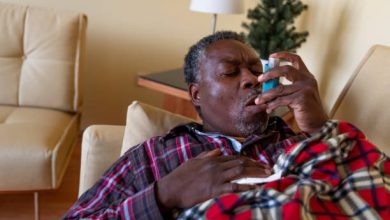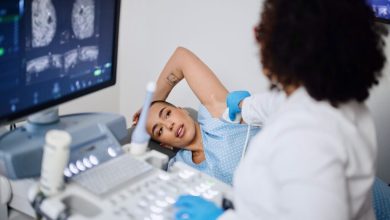What to Do After You’ve Been Diagnosed with Prostate Cancer
Getting a cancer diagnosis can be shocking. If your world feels turned upside down, here are 6 steps you can take to help stand it right-side up again.
In honor of National Prostate Cancer Awareness Month, the African American Wellness Project is teaming up with Linkwell Health, the premier digital content marketing and consumer experience technology company in healthcare, to help spread the word about prostate cancer risks, treatment, and prevention in the African American community.
If your first response to getting a prostate cancer diagnosis was fear, anxiety, or even anger, that’s okay — and perfectly normal. But know that you have loads of resources at your disposal, along with many people to help you through this time.
Plus, there’s reassuring news around prostate cancer: The five-year survival rate for prostate cancer is 99%. “The leading cause of death among most men with prostate cancer is not prostate cancer,” says Stacy Loeb, M.D. She’s a professor of urology at NYU Grossman School of Medicine. “The likelihood that you’ll die of this is extremely low.”
While you should give yourself time to take in the news, don’t spend too much time worrying. As soon as the dust has settled, it’s important to start thinking about a treatment plan. After all, you’re on a mission to get better, and there are things you can do to help make that happen. Here’s how to get started.
Step 1: Pause for a beat
Start by reminding yourself that you’re not alone. It’s estimated that more than 268,000 men in the U.S. will get the same diagnosis as you in 2022. And while you might feel the urge to jump into treatment right away, prostate cancer is usually slow growing. Chances are, it’s been quietly sitting inside you, minding its own business, for quite a while. So unless it’s been found at a late stage, there’s no big rush to get it out.
“It’s important to address, of course,” says Dr. Loeb. “But it’s not an immediate emergency.” Talk about your treatment options with your doctor. You’ll likely have time to think about them and make a decision you feel good about.
Step 2: Take your emotional temperature
Are you feeling anxious and depressed? Are you worried about how your prostate cancer treatment might affect your sex life and relationship with your partner? It’s normal to be on edge during this time. But taking steps to ease your stress can help you in the long run.
For one, stress has been shown to lower the effectiveness of treatment and speed up the growth of cancer. What’s more, stressed-out prostate cancer patients are more likely to choose surgery, which may not always be the right option.
For these reasons, it’s important to pay attention to your feelings. And if you’re feeling down, get help. “There are counselors who specialize in depression during and after treatment,” says Dr. Loeb. “And there are also many specialists who help manage side effects.”
Ask your doctor or nurse about resources. You can look online too. Some good places to start:
“Even if you’re not ready to speak, just go to a meeting and listen,” says Dr. Loeb. “If you’re not comfortable telling your story, simply hearing other people sharing theirs can be good. The one thing I don’t recommend is sitting home and not seeking any help at all if you’re having a hard time.”
Step 3: Do your homework
It’s true what they say: Knowledge is power. And you’ll feel more empowered and motivated as a patient if you have a basic understanding of prostate cancer and your diagnosis.
So arm yourself with information about your unique type of prostate cancer. Learn everything you can about possible treatments and side effects. Make sure you have all the important numbers at your fingertips. A few numbers to ask the doctor about include your:
- Stage of cancer. Stage is a measure of the location and size of your cancer, and how far it has spread.
- Gleason score. This score ranges from 6 to 10, with 10 being the highest grade. Your number gives you a sense of how quickly your normal cells change to cancer cells. A high grade means the cells are very mutated and hardly look or act at all like normal cells.
- Prostate-specific antigen (PSA) results. PSA is a protein produced by prostate cells. In general, the higher your PSA number or the more it goes up over time, the more likely prostate cancer is present. Experts don’t yet agree on what numbers are considered normal or high. Talk to your doctor about what your results mean for you.
Finally, if you’re doing your research online, be cautious. Dr. Loeb led a study that looked at more than 100 YouTube videos about prostate cancer. She found that 77% had biased or misinformed content. “If you’re not going to reliable, vetted websites, there’s a high probability you’re getting bad information,” Dr. Loeb says.
Stick with trusted sources such as the American Cancer Society and the Prostate Cancer Foundation. And if you have questions about what you’re learning, always discuss them with your doctor.
Step 4: Get a second opinion
It’s a good idea to seek advice from more than one doctor. That’s especially true if you’re concerned that you haven’t explored all your options, or if you and your doctor don’t communicate well.
“It’s important to get an opinion from different types of specialists,” adds Dr. Loeb. In addition to a urologist, she recommends seeing a radiation oncologist and a medical oncologist. You can often find experts with these specialties under one roof at an academic medical center or a private practice. That means you might be able to get multiple medical opinions on the same day.
You can also ask your first doctor for suggestions. “‘Are there any other types of doctors I should speak to?’ is a useful question,” says Dr. Loeb. Another great resource: the American Society of Clinical Oncology’s Find a Doctor tool.
Step 5: Make exercise a priority
As tempting as it might be to sit at home and mope after a cancer diagnosis, resist the urge to do it. Instead, get outside and get moving. Men with prostate cancer who exercised the most were 30% more likely to live longer and healthier lives than those who exercised the least in a study conducted by the American Cancer Society.
“The more fit you are, the better you’ll get through your treatments,” Dr. Loeb says. “Exercise is especially important if you’re on hormone therapy, which can decrease your muscle mass and increase your fat mass. Plus, it increases your energy and helps to mitigate other side effects.”
You don’t have to run a marathon: Another study showed that walking at an easy pace for just three hours a week was enough to reduce the side effects of prostate cancer treatments.
Step 6: Eat healthy
Good nutrition can help you stay stronger during your treatments. A good rule of thumb: Eat less red meat and more vegetables.“There’s no specific diet cure,” Dr. Loeb says. “But eating well can help you feel better — and help increase your longevity in general.”
Sources:
“Key statistics for prostate cancer.” American Cancer Society, January 12, 2022, available at https://www.cancer.org/cancer/prostate-cancer/about/key-statistics.html#:~:text=The%20American%20Cancer%20Society’s%20estimates,new%20cases%20of%20prostate%20cancer. Accessed August 1, 2022.
Orom H, Underwood W, and Biddle C. “Emotional distress increases the likelihood of undergoing surgery among men with localized prostate cancer.” The Journal of Urology, February 2017; 197: 350-355.
Friedenreich CM, Wang Q, Neilson HK, et al. “Physical Activity and Survival After Prostate Cancer.” European Urology, vol. 70, no. 4, October 2016, pp: 576-587.
Phillips SM, Stampfer MJ, Chan JM, et al. “Physical Activity, Sedentary Behavior, and Health-Related Quality of Life in Prostate Cancer Survivors in the Health Professionals Follow-Up Study.” Journal of Cancer Survivorship, vol. 9, April 16, 2015, pp: 500-511.




